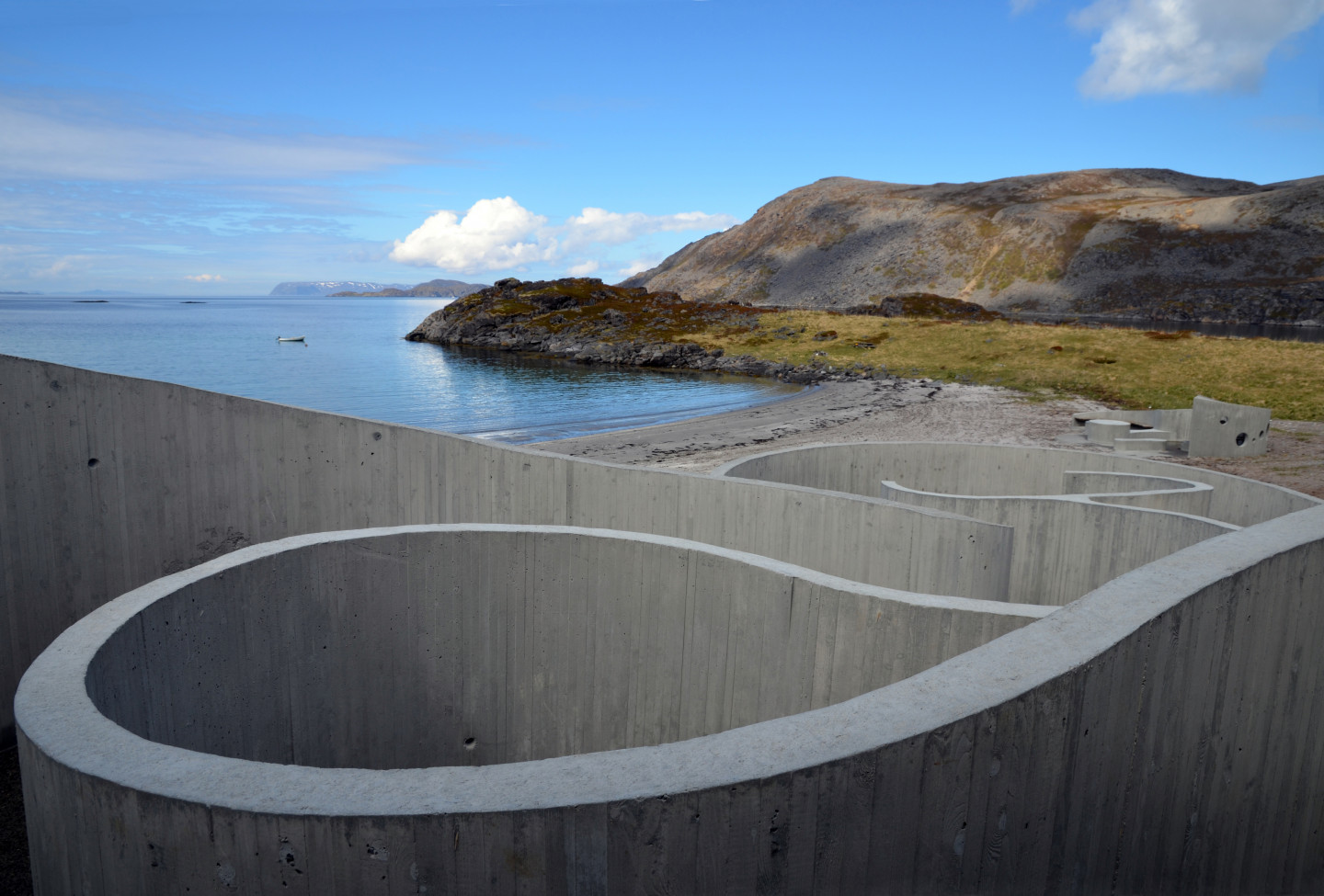Description / The roadside stop is a part of the development of the National Tourist Route between Kokelv and Havøysund. The route follows the Arctic Ocean and meanders through a rugged landscape of cliffs and untamed nature where the bare mountains touch the ocean’s edge.
The project’s starting point is a fascination of the nature and landscape of Selvika, in Måsøy Municipality. This was the home of people for five thousand years, until 1944. Their settlements always consisted entirely of turf huts, and its traces may be found in pits for processing whale oil dating back to 100 BC. The location emerges like an oasis in an otherwise barren landscape.
The distinctive rock formations, the green turf, the sandy beach and the ocean. The roadside stop invites the visitor to a slow wander in the beautiful, open and rough landscape. The meandering walkway from the road towards the beach, provide the framework to experience the nature and location from different viewpoints. The walk ends at a focal point and gathering place with fireplace, outdoor kitchen and benches. At the car park, the project includes sheltered bicycle racks and an information point, as well as a small service building with toilet facilities.
The project sits gently in the terrain and far away from the listed turf huts of the area. The whole construction is cast in-situ with light grey concrete which fits the character of its surrounding landscape. The roadside stop is intended as a new architectural element in the powerful landscape that may enhance the experience further.
Careful site surveys were conducted to ensure that the structure is adapted to its location in terms of heights, design and extent.
Background and design / The design will enhance the experience of moving from the road to the beach and water at this particular place. A major challenge is to slow the pace of the movement and use the pathway as a means to create awareness of the surrounding by opening up new sightlines and experiences for the visitor.
The primary functional focus was disabled access. As opposed to proposing a solution consisting of both stairs and a ramp, we made the ramp a joint walkway for a holistic project character. The walkway meanders through the natural terrain from the car park by the road to the beach. The sculptural structure is based on a study of the organic forms of seashells. A series of radii of different dimensions were joined into a geometrical sequence for the project.
Usage / Selvika is located in a sheltered bay and frequented by the population of Havøysund during the summer season. At the same time, the project invites travelers to stop and rest. The project therefore encompass a wide range of uses with car park, sheltered bicycle racks, public toilet facilities, disabled accessible ramp with seating, and a gathering place with fireplace, grill and preparation table.
Material selection and construction / The location is characterized by a harsh climate where the sea thrash against the land for large parts of the year. Concrete is chosen as primary construction material for its plasticity in design, as well as its solidity and ability to weather well over time. The entire project is joined together by a continuous structure of in-situ concrete with vertical timber formwork. Supplementary materials include prefabricated elements of wood, steel and glass.
In advance of the construction period, we conducted a course for the construction crew focusing on the execution of in-situ concrete, including themes concerning:
- the composition and desired mix of concrete,
- reinforcement and consequences of mistakes,
- approach to formwork,
- casting and finishing of concrete,
- cold weather concreting,
- casting in-situ joints, and
- casting of trial panels.
The concrete uses locally sourced aggregate and is white pigmented with titanium dioxide.
Following careful examination of in-situ test and considerations of the conditions for casting, we decided to use standing vertical timber formwork for all the vertical surfaces of the design. 35mm timbers with trapezoidal profile were positioned accurately to minimize the gap between boards and make the winding effect as even and dynamic as possible.
The boards were chamfered in the inner curves to be positioned edge to edge without gaps. The outer curves and straight corners had boards edge to edge without chamfers.
Prior to casting the formwork was moisture-treated to avoid gaps. The formwork used as few as possible tie holes, which were positioned by the architect. The holes were made using sections of industrial pipes and placed according to direction and position.
The flooring of the walkway is finished in washed concrete exposing the finer particles of the aggregate to secure a tactile and slip resistant surface, without revealing the coarse aggregate below. The flooring of toilet facilities is polished concrete treated with pore sealant, while its ceiling was smoothly cast with sheet formwork. The concrete seating and benches are very lightly washed in order to achieve a nicely textured surface.
Location: Havøysund, Finnmark, Norway
Program: Architectonic multipurpose landscape structure
Client: Norwegian Public Roads Administration
Size/Value: 5,000 m2 total planning area / 11 MNOK
Commission Type: Direct Commission (2007),
Status: Constructed
Year: 2012
Architect: Reiulf Ramstad Arkitekter AS
Engineering: Dr. Techn. Kristoffer Apeland
Entrepreneur: T. Johansen Drift AS, Alta Rør AS and Elektro Nord AS
Manufacturers: Arnesen Betong AS, Alta Stål & CNC Maskinering AS
Concrete Consultant: T. Noason
Construction Cost: 11 million NOK
Photography: Reiulf Ramstad Arkitekter AS

